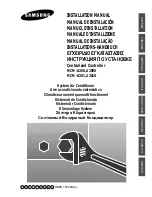
46 | reFrIGerant deSIGn
Single Zone High Efficiency W
all Mount Engineering Manual
Due to our policy of continuous product innovation, some specifications may change without notification.
©
LG Electronics U.S.A., Inc., Englewood Cliffs, NJ. All rights reserved. “LG ” is a registered trademark of LG Corp.
inSTAllATion & lAyoUT beST PrAcTiceS
no Pipe Size Substitutions
Using a different size is prohibited and may result in a system malfunction or failure to work at all.
in-line refrigeration components
Components such as oil traps, solenoid valves, filter-dryers, sight glasses, tee fittings, and other after-market accessories are not permitted
on the refrigerant piping system between the outdoor unit and the indoor unit. Single Zone Wall Mount systems are provided with redundant
systems that assure oil is properly returned to the compressor. Sight-glasses and solenoid valves may cause vapor to form in the liquid
stream. over time, dryers may deteriorate and introduce debris into the system. The designer and installer should verify the refrigerant
piping system is free of traps, sagging pipes, sight glasses, filter dryers, etc.
Pipe Supports
A properly installed pipe system should be adequately supported
to avoid pipe sagging. Sagging pipes become oil traps that lead to
equipment malfunction.
Pipe supports should never touch the pipe wall; supports shall be
installed outside (around) the primary pipe insulation jacket (see
Figure 21). Insulate the pipe first because pipe supports shall be
installed outside (around) the primary pipe insulation jacket. Clevis
hangers should be used with shields between the hangers and
insulation. Field provided pipe supports must meet local codes. If
allowed by code, use fiber straps or split-ring hangers suspended
from the ceiling on all-thread rods (fiber straps or split ring hangers
can be used as long as they do not compress the pipe insulation).
Place a second layer of insulation over the pipe insulation jacket to
prevent chafing and compression of the primary insulation within the
confines of the support pipe clamp.
A properly installed pipe system will have sufficient supports to avoid
pipes from sagging during the life of the system. As necessary,
place supports closer for segments where potential sagging could
occur. Maximum spacing of pipe supports must meet local codes.
If local codes do not specify pipe support spacing, pipe must be
supported:
• Maximum of five feet (5′) on center for straight segments of pipe up
to 3/4" outside diameter size.
Wherever the pipe changes direction, place a hanger within twelve
(12) inches on one side and within twelve to nineteen (12 to 19)
inches of the bend on the other side as shown in Figure 22.
Figure 20: Installing Piping Above and Below an obstacle.
Figure 21: Piping Hanger Details.
Figure 22: Typical Pipe Support Location—
Change in Pipe Direction.
Max. 12"
~ 12" – 19"
A
B
A + B ~ 12" – 19"
obstacles
When an obstacle, such as an I-beam or concrete T, is in the path
of the planned refrigerant pipe run, it is best practice to route the
pipe over the obstacle. If adequate space is not available to route
the insulated pipe over the obstacle, then route the pipe under the
obstacle. In either case, it is imperative the horizontal section of pipe
above or below the obstacle be a minimum of three (3) times greater
than the longest vertical rise (or fall) distance. Refer to Figure 20.
Above an obstacle.
3X
Below an obstacle.
refrigerant Piping System Layout
Figure 23: Pipe Support at Indoor Unit.









































